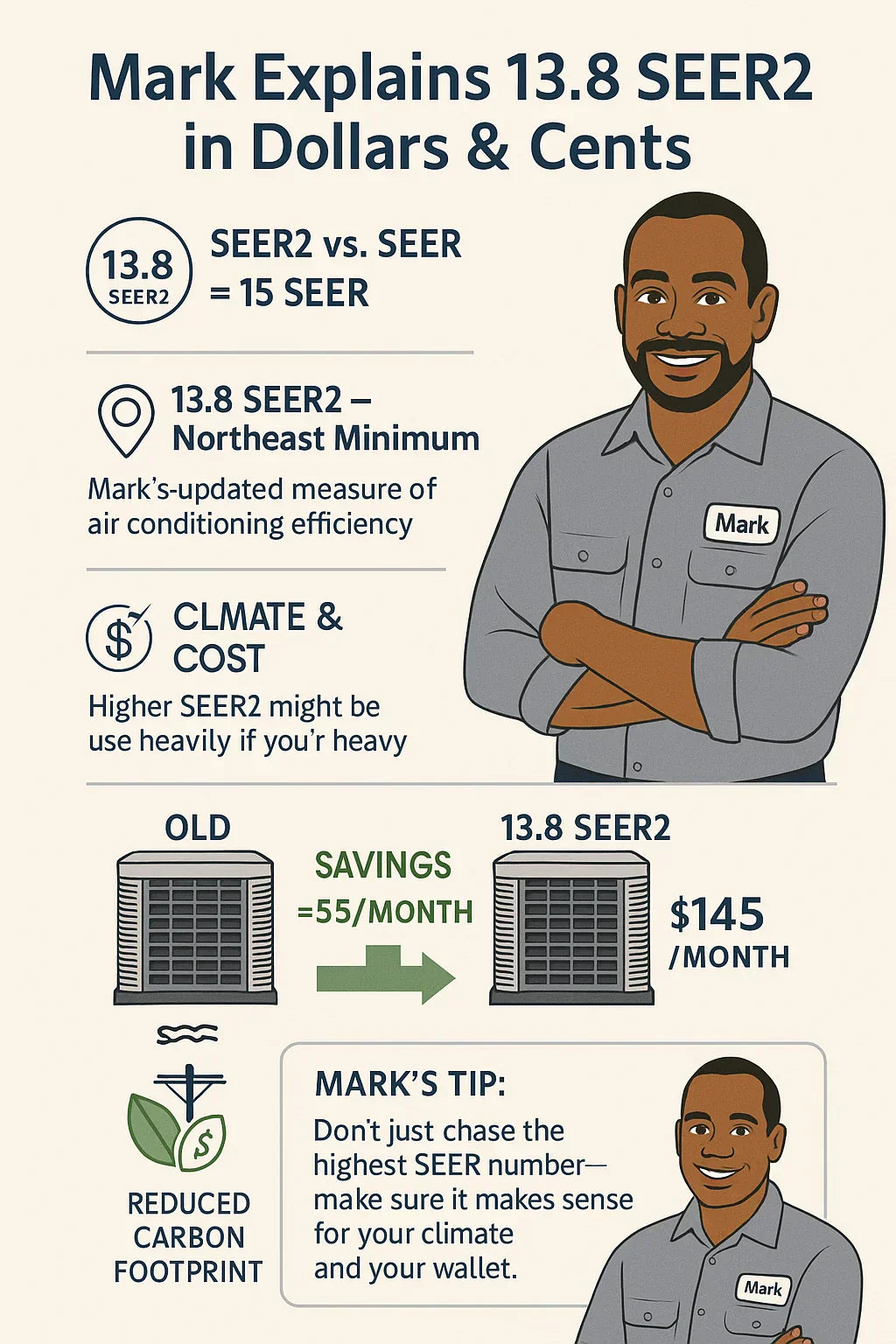If you’ve been shopping for a new air conditioner in 2025, you’ve probably noticed the “13.8 SEER2” rating on a lot of Northeast systems. It’s not just a random number—it’s the new efficiency standard for our region.
But here’s the thing most folks don’t know: SEER2 isn’t just a label—it directly impacts how much you’ll spend (or save) on your monthly energy bills.
In this guide, I’ll explain what SEER2 really measures, why 13.8 is the new baseline, and how it affects your wallet when the summer heat rolls in.
⚙️ What Is SEER2, Anyway?
SEER2 stands for Seasonal Energy Efficiency Ratio 2. It’s the updated version of SEER, the metric we’ve used for decades to measure AC efficiency.
-
SEER (old method): Measured performance in ideal lab conditions.
-
SEER2 (new method): Uses stricter testing that mimics real-world conditions, including ductwork restrictions.
👉 Translation: SEER2 ratings are tougher and more realistic. A unit rated at 13.8 SEER2 today is roughly equivalent to a 15 SEER under the old standard.
DOE explains SEER2 testing changes here
📉 Why Did SEER2 Replace SEER?
The U.S. Department of Energy (DOE) updated the testing method because old SEER numbers weren’t telling the full story.
In real homes:
-
Ducts restrict airflow.
-
Systems face hot attics and basements.
-
Humidity control matters as much as temperature.
The new SEER2 accounts for these challenges. So, when you see 13.8 SEER2, you’re looking at a system tested under conditions that actually resemble your home in the Northeast.
📍 Why 13.8 SEER2 Is the Northeast Minimum
Here’s where it gets regional.
-
Southern states (where AC runs longer) now require 14.3 SEER2.
-
Northern states (including the Northeast) have a slightly lower minimum of 13.8 SEER2.
Why? Because AC usage is seasonal and shorter in the Northeast. Regulators balanced efficiency with affordability.
👉 That’s why Goodman designed the 2.5 Ton 13.8 SEER2 Northeast System—it’s built specifically to meet DOE rules without overburdening homeowners with unnecessary cost.
Learn more about regional standards at ENERGY STAR
📊 How SEER2 Affects Your Energy Bills
Now let’s talk money.
The formula for calculating cooling cost is:
A 2.5-ton system = 30,000 BTUs.
Let’s assume:
-
Cooling season: 1,200 hours per year (average Northeast usage).
-
Electricity rate: $0.20 per kWh (regional average).
👉 With a 13.8 SEER2 system:
So you’d spend about $521/year on cooling with a 13.8 SEER2 unit.
🏚️ Comparing to Older Units
Most homeowners I meet are replacing systems that are 10–14 SEER from the 1990s or 2000s.
Here’s the side-by-side:
-
Old 10 SEER unit: ~$718/year
-
New 13.8 SEER2 unit: ~$521/year
-
Savings: ~$197/year
Over 10 years, that’s almost $2,000 in savings, not counting maintenance improvements.
👉 If your unit is even older (8–9 SEER), savings climb higher.
Consumer Reports confirms the impact of upgrading efficiency here
🌦️ Why Savings Vary in the Northeast
Your exact savings depend on how much you actually run your AC.
-
Hotter Northeast cities (NYC, Philly, DC area): Longer seasons, higher bills, more savings potential.
-
Cooler Northeast areas (Vermont, Maine): Shorter seasons, smaller bills, less savings—but you still benefit from reliability.
-
Humidity factor: Even in cooler areas, a system that dehumidifies properly will feel more comfortable and save money by running less.
Climate data from NOAA can give you average cooling hours by region
📐 SEER2 vs. Real-World Comfort
Efficiency isn’t just about money—it’s about comfort.
Here’s what I see in homes:
-
A new 13.8 SEER2 Goodman runs longer cycles, meaning better humidity control.
-
Old oversized units blast cold air but leave rooms clammy.
-
Properly sized and efficient systems save money AND improve comfort.
👉 In the Northeast, balance is everything. You don’t need 20 SEER systems unless you have very high usage.
💵 Payback Period: When Does 13.8 SEER2 “Pay for Itself”?
Let’s break it down.
-
Cost of a new Goodman 2.5 Ton 13.8 SEER2 system (installed): ~$4,500–$6,500
-
Annual energy savings vs. old 10 SEER: ~$200
-
Payback period: ~22–25 years purely on efficiency
But here’s the kicker: You’re not just buying efficiency. You’re buying:
-
Fewer breakdowns
-
Better comfort
-
Compliance with new DOE rules (old units can’t be installed after 2023)
Learn more about HVAC lifecycle costs at ENERGY STAR
⚖️ Should You Go Higher Than 13.8 SEER2?
Sometimes, yes.
Go higher if:
-
You live in a hotter Northeast metro with high AC use.
-
Your utility offers rebates for higher SEER2 systems.
-
You plan to stay in your home 15+ years.
Stick with 13.8 if:
-
You use AC only 3–4 months per year.
-
Your budget is tight, and you’d rather spend on better insulation first.
-
You want a solid, compliant system without overspending.
DSIRE database of energy rebates here
🛠️ Mark’s Pro Tips on SEER2
-
Don’t just chase numbers. A well-installed 13.8 SEER2 will outperform a poorly installed 16 SEER2.
-
Ask about ductwork. Leaky ducts waste up to 30% of energy savings.
-
Balance SEER2 with comfort. Humidity removal is as important as efficiency.
-
Check rebates. Sometimes a small upgrade in SEER2 pays for itself with incentives.
-
Trust but verify. Always ask your installer to run a Manual J load calculation before recommending a system.
Learn about duct sealing benefits from ENERGY STAR
✅ Bottom Line: What 13.8 SEER2 Means for You
Here’s my takeaway after 15 years of installs in the Northeast:
-
A 13.8 SEER2 Goodman system will save most homeowners 15–30% on cooling bills compared to their old AC.
-
It’s the minimum standard for the region—meaning it balances affordability and efficiency.
-
Unless you run AC all summer long or get strong rebates, 13.8 SEER2 is plenty for most Northeast homes.
👉 In plain English: It’s not the flashiest number, but it gets the job done without draining your wallet.
In the next topic we will know more about: Installation Guide: What Mark Looks for When Setting Up a Goodman 2.5 Ton System







